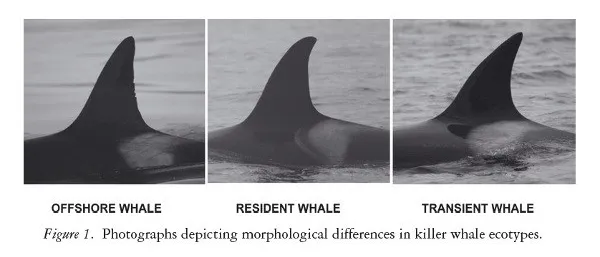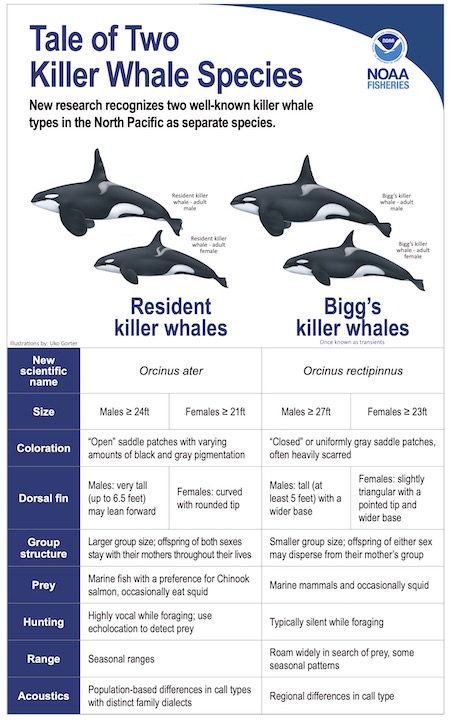Transient and Southern Resident Orcas Distinctly Different, DNA Shows
September 6, 2024
In late August, scientists at SE Farallon Island observed a pack of Killer Whales hunting a group of humpback whales. Over a period of nearly 9 hours the predators pursued and harassed the Humpbacks, apparently focusing in on one individual. Although killer whales, or orcas, are known to hunt and kill baby gray whales or sick whales, attacks on the far larger adults are rare. Killer whales are among the most widespread group of whales globally. Until last year, scientists considered killer whales, to be one species known as Orcinus orca, with distinct groups in various regions known as “ecotypes.”
In the Gulf of the Farallones, the most common ecotype is known as the Transients or Biggs Ecotype. The Transients were the group identified in the humpback whale event last month. These orcas eat mammals, but are known to occasionally prey on seabirds, possibly squid, and occasionally even great white sharks too.
The other most common orca in the sanctuary is the Southern resident killer whales. These orcas are fish eaters, with salmon as their preferred prey. This ecotype lives primarily in the waters around the Salish Sea off Washington, but individuals have been identified as far south as Monterey. The two ecotypes overlap in range, although it is observed they do not closely interact and do not interbreed.
Through DNA analysis, a 2023 study suggested that the Biggs and Southern Resident Orcas as separate species. The two whales have slight differences in size, coloration and dorsal fin shape.

Although coexisting, the two species use different ecological niches, including specializing in different prey types. Resident killer whales maintain tight-knit family pods and prey on salmon and other marine fish. Bigg’s killer whales roam in smaller groups, preying on other marine mammals such as seals and whales. Bigg’s killer whales, are named after Canadian scientist Dr. Michael Bigg, the first to describe the differences between the two types. However, the species separation has not yet been recognized by the Taxonomy Committee of the Society of Marine Mammalogy.
Genetic data from previous studies suggest that the two species likely diverged more than 300,000 years ago and come from opposite ends of the killer whale family tree. This separation suggests that some of the other ecotypes separated by time and distance are also separate species. Species designation has impacts on their survival and their protection and would increase protection for the Southern Residents.

The California Killer Whale Project (CKWP) a team of researchers based in Monterey has been studying and monitoring Orcas since 2019. The founder, Dr. Nancy Black has been studying killer whales in Monterey Bay since the late 1980s. The team has created a field guide that includes 73 of the Bigg’s killer whales in this population. Using photo ID, the CKWP team can identify individuals and their movements or reappearance over time. The CKWP invites the participation of citizen scientists and images can be submitted, much like the Happy Whale project.
Shark Stewards leads trips into the Gulf of the Farallones and contributes images to these projects, and to the TOPP white shark project at Stanford Hopkins Marine Laboratory.
JOIN US ON A TRIP TO THE FARALLON ISLANDS
Besides the Transients (Bigg’s), and the Resident ecotypes of killer whales occuring in Monterey and off the Farallones, the CKWP has also recorded a less common group of killer whales visiting from the Eastern Tropical Pacific. Referred to as ETPs, these whales may specialize in preying on sperm whales. Though the ETP Orcas are often elusive and frequently travel offshore, drone footage collected by CKWP includes the first known documentation of them foraging on a six-gill shark.
As a separate species, Southern Residents are listed as endangered in part because of the scarcity of salmon, their favored prey. With a large population of California Sea Lions and other pinnipeds, the population of Bigg’s killer whales, is growing along our coast. We hope to see and document more of these amazing whales on our public fall Sharktober trips in to the Greater Farallon National Marine Sanctuary!
References
Revised Taxonomy of Eastern North Pacific Killer Whales (Orcinus orca): Bigg’s and Resident Ecotypes Deserve Species Status
Phillip A. Morin et al 2024 Published:27 March https://doi.org/10.1098/rsos.231368